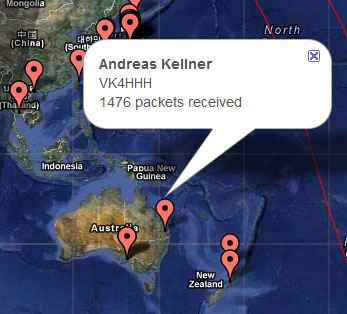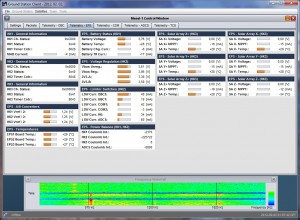New contacts
We carefully save and process all incoming packets, reception reports, CW telemetry data reports and .wav files. To enable us to process the incoming information in an effective way, you are respectfully asked to send your message keeping in mind the following guidelines:
- Logging and sending of the received packets is done automatically by the decoder software. The server-side logging is operating, even if inconsistent information is being shown about it in the SW (see later).
- Only reception reports, CW data, .wav files and other reception-related media should be transmitted via e-mail to A sample reception report is shown on the site For Radio Amateurs.
- If you want to make sure we get the telemetry packets you receive by the SW, you can also mail the .log file in the folder of the SW to Please keep in mind that the processing of packets sent via e-mail takes more time than those sent automatically by the SW. Please also save all the .log files to your computer as these might be needed later.
Refreshed page structure
We are going to collect soon all details necessary for ham reception on the For Radio Amateurs page, such as satellite TX frequency, link for station registration, download link for the current release of the receiver SW, current TLE data and our contact details.
On our new page, Reception statistics you can see the total number of received packets, with the countries and call signs of participating radio amateurs. The data are updated daily at 1:00 UTC.
You can see the daily number of packets received by you on the map on the main page, in the bubbles as shown on the picture below.
Data download when in the coverage zone of Hungary
As currently only our primary and secondary ground stations are equipped with data file reception capabilities, we often command the satellite to data download mode when it is within the coverage of our Budapest ground station. If commanded, the satellite transmits the high-resolution and long-term measurement data with an increased data rate of 1250 bit/sec. These data are necessary for the verification of the satellite’s safe operation. Unfortunately the latest release (as of 18 February 2012) of our public client SW is not able to decode these packets yet, but hopefully we will implement this feature in the next release. This will enable all of you to increase the efficiency of the data transmission.
How to improve packet reception?
We experienced that if the demodulated signal is not arranged in line with the corresponding frequency notes of the frequency waterfall, but arranged upwards by 50-100 Hz, the ratio of successfully received packets increases dramatically. You are invited to experiment with this method and send us your experience to
Server-side data collection acknowledgement
Currently, server-side data logging is implemented without real-time acknowledgement to the clients, despite the "Offline" notation which may have led to confusion. We are sorry about the inconvenience it may have caused. The "Offline" notation does not mean that there is no connection with the server; this is just a notice of a not-yet-implemented feature. This will be corrected in the next release.
Until we implement real-time acknowledgement, you can see the daily number of packets received by amateurs in the bubbles on the map of the main page, and also in the Reception statistics page showing the number of incoming packets (update daily at 1:00 UTC). This way you can verify that we successfully received your packets.
Data security and using the SW
We received some feedback about firewalls disabling the operation of our SW. We would like to ensure all of you that the only data transmitted to us (and saved to the log files) are the satellite’s packets, time stamps and the mail address you provided at the beginning of using the SW.
If you wish not to send us your e-mail address but you would still like to help us with sending us packets, you can enter or [email protected] as mail address and the SW will accept it. If you wish to change the e-mail address you provided, you can do it with editing the registration.txt file in the program folder.
Masat-1 engineering copy transmitting from the ground
We regularly power on the engineering copy of the satellite to carry out specific measurements regarding the next day’s satellite operations. This affects radio amateurs near our Budapest ground stations (most of whom are in Hungary). During these measurements the engineering copy transmits signals which (at first sight) may seem completely identical with those transmitted by Masat-1 from the space. This may lead to the decoder SW receiving these "mock"-packets filled with inconsistent data (e.g. battery down warning, etc.) We would like to apologise to all of you for the inconvenience these "mock"-packets may have caused.
Of course we never power on the engineering copy if the satellite is within reach of our Budapest ground station, as it would destroy our and other radio amateurs’ reception in the area.
If you are not sure whether the signal you are currently receiving is coming from the satellite or the engineering copy, please observe if there is a change of the transmit frequency or the signal strength. Doppler-effect causes a constant change in the received frequency, therefore the pitch of the demodulated signal is constantly changing (if not corrected).
MNI TNX to HAMs!
We would like to express our deepest gratitude for all of you who contributed to the success of the mission with receiving the satellite, sending us reception reports or data packets.
We count on you during the upcoming period as well, and we also encourage all those interested to join.
73,
the Masat-1 Team
MNI TNX to HAMs!
We proudly report that our satellite has been operating for more than 4 days without any issues.
We have been extremely enthusiastic since we first noticed the endless flow of received packets from all around the world, giving an unbiased proof of the satellite’s operation. We carefully collect and process all reception reports, audio recordings and log files. We would like to note that automatic packet sending is active in the receiver software, despite the “Offline” notation. 🙂
The map on our website shows labels for all receiving stations where the number of receiver packets sent via the client software or e-mail is listed.. The data are updated every day at 01:00 AM UTC.
Frequency waterfalls, videos and reports about receiving Masat-1 are appearing all over the internet. Thank you very much for receiving our satellite, it is a pleasure to experience such attention.
At the ground station
Our team has been present at our primary and secondary ground stations during every single pass of the satellite since launch, ensuring continuous coverage. We are lucky as we are able to track even the passes with really low elevation and short duration, extending our opportunities to receive data and send commands.
The orbital period is approx. 102 minutes with 2-3 available passes in the early morning and 2-3 passes during the afternoon. During these passes, a staff of 2-3 operates the ground station and an additional team of 2-3 carries out on data processing and other tasks. Someone is constantly controlling the radio during the passes, and a second person is dealing with satellite commanding and reception using the ground station software. A third (optional) person is monitoring the orbit of the satellite before and during the pass, and informs the team about the timing of the pass, giving a real sense of time for the staff. This third person is also taking notes of the received signals’ frequency shift, from these notes it was possible to determine which NORAD object is Masat-1. A fourth person has the task of “spotting” the satellite’s current frequency at the beginning of the pass, he operates an individual radio receiver . Fortunately the automatic Doppler correction works well, so this fourth person often has some time to look for the signals of other Vega-launched satellites. The additional support staff of 2-3 records the audio of the passes and also answers questions related to their satellite subsystem if required, assisting the work of those operating reception and telecommands.
After the pass, 10-20 minutes are spent with the discussion of the previous actions, then we get refreshed and start to prepare for the next pass. It is coming every 102 minutes…
Report on the satellite’s status
Thanks to radio amateurs, the continuous packet reception provides a global coverage of telemetry data, enabling the team to concentrate on recording and download of high resolution measurement data. This is the reason why the satellite can often be heard transmitting a continuous packet downlink with 1250 bits/sec above Hungary. The public version of the decoding software is not yet prepared for this high-speed data downlink, it only operates with 625 bits/sec. The next release of the software (published soon) will be capable of decoding these high-speed packets as well.
The high-resolution long term measurements provide a deeper insight to the operation of each subsystem. Now we are examining the thermal equilibrium, the energy balance and the basic parameters of the attitude control system.
As many of you might have noticed, the satellite is in a state of slow rotation, therefore sometimes the antenna is pointing towards the receiving station. This causes the signal to fade and the packet reception to pause. It was not a long time ago when we started to download the file which was recorded by the satellite after the ejection from the P-POD, above the Pacific Ocean. The satellite was in silent mode with closed antenna, recoding some data of itself. From the downloaded data it is clear that the satellite had a rotation speed of 2-3 rpm after ejection. Currently we operate the attitude control system in passive, data collection mode. The verification of specific parts of the control system is made from the data collected. If the data are in line with our expectations, we will turn on the attitude control system. We do not want to hurry with this, as it would mean that we have already reached the last milestone at the very beginning of operation. 🙂
Many functionalities are to be tested in the next period, and we also have measurement data form the first day which is to be downloaded later. It is very easy to “overplan” the data collection, resulting in a huge amount of data. We hope to publish the high-speed capable version of the receiving software as soon as possible, improving downlink efficiency. Besides, it is worth to note that more than 1 MB of data has been downloaded from the satellite so far, due to radio amateur contributions.
That is all for now, we wish you a successful satellite tracking!
We are extremely thankful of those who received the signals of Masat-1 from all over the world. A quick summary:
Total no. of received packets: 4569
Total no. of participating radio amateurs: 40
Participating countries (where radio amateurs are located who received packets):
(not exhaustive, we are extending the list)
Argentina
Australia
Brazil
United States of America
France
The Netherlands
Japan
Canada
Hungary
United Kingdom
Russia
Romania
Slovakia
We will launch a site soon where you will find detailed data about participants and their statistics. This number does not involve the packets received by our ground station, which was more than 1500 during the first 24 hours. Also not involved are the reports sent by email before today, as the processing of these packages is not done yet. Meanwhile, a quick exercise for those interested: the size of a single data packet is 64 byte. What is the amount of data which was collected so far? 🙂
Today we tracked our satellite many times and based on the observations we think that this is the corresponding TLE set for Masat-1. It was published on Celestrak.
Masat-1 1 38079U 12006C 12045.34563505 .00003646 00000-0 10000-3 0 50 2 38079 69.4892 236.7638 0781145 43.1829 322.8098 14.05512214 125
Hungary’s first satellite in orbit! Watch the final countdown:
University
Cooperation
Sponsors
- AduPrint
- Altium
- Anico Kft.
- Azurspace
- BL-Electronics
- Bonn Hungary
- Carinex
- ChipCAD
- COOPTIM Ipari Kft
- Dension
- DND Telecom Center Kft.
- DSI Informationstechnik
- Dunaújvárosi Főiskola
- EADS Astrium GmbH
- ELMŰ
- Europrint
- Evosoft
- Exasol Kft.
- Faludi Wolf Theiss
- Farmelco Kft.
- GD Gép és Daru Kft.
- HFT Kft.
- HP Magyarország
- Hungaro DigiTel Kft.
- Infoterra Hungary Kft
- KFKI RMKI
- LHT Budapest
- LOMEX
- Magnetec-Ungarn
- Magyar Villamos Művek
- Magyarok a Marson
- Microchip
- National Instruments
- Nikon
- NMHH
- NuSil
- Paksi Atomerőmű
- Puskás Technikum
- Rádióvilág
- Ricoh Hungary Kft.
- RSOE
- Sagax Kft.
- SGF Kft.
- Siemens
- Silicon Labs
- Sphere Consulting Kft.
- Totaltel
- Űrvilág Hírportál
- Wacker Chemie
Design tools
Calendar
| M | T | W | T | F | S | S |
|---|---|---|---|---|---|---|
| 1 | 2 | 3 | 4 | 5 | 6 | 7 |
| 8 | 9 | 10 | 11 | 12 | 13 | 14 |
| 15 | 16 | 17 | 18 | 19 | 20 | 21 |
| 22 | 23 | 24 | 25 | 26 | 27 | 28 |
| 29 | 30 | |||||















